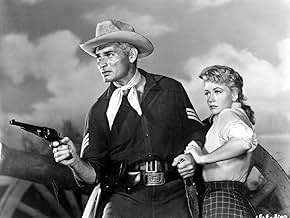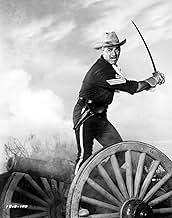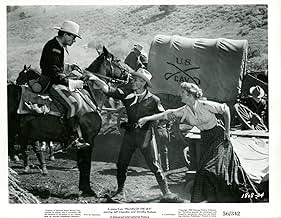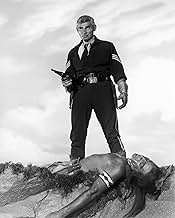NOTE IMDb
6,2/10
829
MA NOTE
Ajouter une intrigue dans votre langueIn 1868 Oregon, after the Army violates the treaty by building a road across the reservation, several tribal chiefs decide to unite their forces against the trespassing whites.In 1868 Oregon, after the Army violates the treaty by building a road across the reservation, several tribal chiefs decide to unite their forces against the trespassing whites.In 1868 Oregon, after the Army violates the treaty by building a road across the reservation, several tribal chiefs decide to unite their forces against the trespassing whites.
- Réalisation
- Scénario
- Casting principal
Avis à la une
Pillars of the Sky (AKA: The Tomahawk and the Cross) is directed by George Marshall and adapted to screenplay by Sam Rolfe from the novels "Frontier Fury" & "To Follow a Flag" written by Will Henry. It stars Jeff Chandler, Ward Bond, Dorothy Malone, Keith Andes and Lee Marvin. A Technicolor/CinemaScope production, photography is by Harold Lipstein and music is by Joseph Gershenson.
Oregon County 1868, and the Native Indian tribes have been shunted on to government sanctioned reservations. As the U.S. troops arrive to lay the roads through Indian territory for new settlers, the Indian chiefs decide to fight back. Led by Chief Kamiakin (Michael Ansara), the Indians attack leaving the army short on numbers, all that's left is a small band of soldiers and some civilians. Can they survive on guts and religious comfort alone?
It was originally intended to be made with John Ford directing and John Wayne starring, but come 1956 the pair were unable to commit to the production. They had another Western to make that year, The Searchers! Plot is familiar for Pillars of the Sky, but the even handed portrayal of the Indians and a pro-Christian bent in the narrative, lifts it out of the ordinary. Picture is further boosted by some excellent action sequences that are skilfully crafted by director Marshall (Destry Rides Again/How the West Was Won). Indian attacks, via horseback or flaming arrows assault, considerably raise the pulse, while the sight of the army desperately trying to conquer the rocky terrain while under attack is a bona fide piece of Oater grit. With the exteriors actually filmed on location in Oregon at Joseph & La Grande, the backdrop is gorgeous, expertly brought to life in Technicolor "Scope" by Lipstein (No Name on the Bullet/Von Ryan's Express). While Gershenson (Horizons West/The Man from the Alamo) scores it with genre compliant riffs on Cavalry marches and Indian flavouring.
That it isn't better known or thought of higher comes down to a so so set of acting performances and a pointless love triangle that pads the picture out with boorish periods of chat. Malone, looking beautiful as per usual in colour, is basically a token character, who serves only to be a romantic interest that causes friction between Chandler and Andes. In fact her dialogue is minimal. Marvin has only a small role, and he offers up a quite poor Irish accent as well, while Andes fails to convince. Chandler does cut a decent rugged figure, portraying First Sergeant Emmett Bell as a man you would fight alongside, but it's a performance that lacks charisma, something that Duke Wayne no doubt would have brought to the role. It's left to Bond to take the acting honours, where in an unusually restrained role for him as strongly Christian Dr. Joseph Holden, he gives good value for money as he plays it out with stoic nobility.
With a great DVD transfer and the correct aspect ratio used, the film looks absolutely terrific. It has flaws for sure, but it comes easily recommended to the Western fan. 7/10
Oregon County 1868, and the Native Indian tribes have been shunted on to government sanctioned reservations. As the U.S. troops arrive to lay the roads through Indian territory for new settlers, the Indian chiefs decide to fight back. Led by Chief Kamiakin (Michael Ansara), the Indians attack leaving the army short on numbers, all that's left is a small band of soldiers and some civilians. Can they survive on guts and religious comfort alone?
It was originally intended to be made with John Ford directing and John Wayne starring, but come 1956 the pair were unable to commit to the production. They had another Western to make that year, The Searchers! Plot is familiar for Pillars of the Sky, but the even handed portrayal of the Indians and a pro-Christian bent in the narrative, lifts it out of the ordinary. Picture is further boosted by some excellent action sequences that are skilfully crafted by director Marshall (Destry Rides Again/How the West Was Won). Indian attacks, via horseback or flaming arrows assault, considerably raise the pulse, while the sight of the army desperately trying to conquer the rocky terrain while under attack is a bona fide piece of Oater grit. With the exteriors actually filmed on location in Oregon at Joseph & La Grande, the backdrop is gorgeous, expertly brought to life in Technicolor "Scope" by Lipstein (No Name on the Bullet/Von Ryan's Express). While Gershenson (Horizons West/The Man from the Alamo) scores it with genre compliant riffs on Cavalry marches and Indian flavouring.
That it isn't better known or thought of higher comes down to a so so set of acting performances and a pointless love triangle that pads the picture out with boorish periods of chat. Malone, looking beautiful as per usual in colour, is basically a token character, who serves only to be a romantic interest that causes friction between Chandler and Andes. In fact her dialogue is minimal. Marvin has only a small role, and he offers up a quite poor Irish accent as well, while Andes fails to convince. Chandler does cut a decent rugged figure, portraying First Sergeant Emmett Bell as a man you would fight alongside, but it's a performance that lacks charisma, something that Duke Wayne no doubt would have brought to the role. It's left to Bond to take the acting honours, where in an unusually restrained role for him as strongly Christian Dr. Joseph Holden, he gives good value for money as he plays it out with stoic nobility.
With a great DVD transfer and the correct aspect ratio used, the film looks absolutely terrific. It has flaws for sure, but it comes easily recommended to the Western fan. 7/10
That scene,when the good doctor courts danger ,when he comes towards an army of angry bloodthirsty Indians ,strongly reminds you of that scene in "the war of the worlds" (1953) when Uncle Matthews ,the minister ,faces up to the Martians ,a Bible and a cross in his hands .But those Indians were supposed to be Christians whereas the ETs were not .Which would tend to show that religion does necessarily calm people down !Jeff Chandler is efficient as sergeant Bell but the love affair is totally bland and Dorothy Malone is totally wasted (hardly 10 lines to say in the whole movie)-she would win an AA for her next movie the famous "written on the wind" melodrama -.Some (Indian only) sadism in certain scenes.
Slow-paced story gets off to a ponderous start with too much talk and too little action, with only some gorgeous scenery for eye comfort. The fault seems to be George Marshall's sluggish direction of a uniformly bland cast.
All of the actors go through their paces in rather standard roles, including JEFF CHANDLER, KEITH ANDES, WARD BOND and LEE MARVIN and for a western that promises some action when the plot thickens, it's a good half-hour before the conflict between cavalry and Indians provides any thrills.
DOROTHY MALONE has the only substantial female role, as a woman no longer in love with her husband. In make-up and hairstyle, she looks and acts more as though she's a woman of modern times rather than frontier days. The romantic triangle (Malone, Chandler, Andes) is a weak one.
The big set piece is the Indian attack that occurs an hour into the film and wipes out most of the command. It's well staged and vigorously mounted for western action. But it comes too late to alter the slow pacing of most of the story which is either Marshall's or the scriptwriter's fault.
A minor quibble: All of the night scenes have a soundstage look to them, in sharp contrast to all the daytime locations.
Summing up: Lackluster western needed the John Ford touch from George Marshall, with Lee Marvin and his Irish accent less than credible in the sort of supporting role Victor McLaglen usually played. Nothing more than average.
All of the actors go through their paces in rather standard roles, including JEFF CHANDLER, KEITH ANDES, WARD BOND and LEE MARVIN and for a western that promises some action when the plot thickens, it's a good half-hour before the conflict between cavalry and Indians provides any thrills.
DOROTHY MALONE has the only substantial female role, as a woman no longer in love with her husband. In make-up and hairstyle, she looks and acts more as though she's a woman of modern times rather than frontier days. The romantic triangle (Malone, Chandler, Andes) is a weak one.
The big set piece is the Indian attack that occurs an hour into the film and wipes out most of the command. It's well staged and vigorously mounted for western action. But it comes too late to alter the slow pacing of most of the story which is either Marshall's or the scriptwriter's fault.
A minor quibble: All of the night scenes have a soundstage look to them, in sharp contrast to all the daytime locations.
Summing up: Lackluster western needed the John Ford touch from George Marshall, with Lee Marvin and his Irish accent less than credible in the sort of supporting role Victor McLaglen usually played. Nothing more than average.
Given the basically no-star cast and the fact that it came from Universal-International, it's understandable that you might think this would be just another run-of-the-mill "B" oater--and you'd be dead wrong. This first-rate western has several things going for it. The breathtaking Oregon locations have been beautifully captured by Harold Lipstein's expert Technicolor cinematography. The colors are lush, and the photography is so atmospheric you can almost feel the chill in your bones as the troops slog through the rugged mountain country. There are several rousingly staged and exciting action scenes, notably a somewhat lengthy sequence in which a wagon train loaded with troops cuts its way through a mass of charging Indians. The performances by a cast of veteran character actors--Lee Marvin in an early role (although his Irish brogue is a bit much), Keith Andes, Charles Horvath, Alberto Morin and Willis Bouchey, among others--are top-notch, Dorothy Malone is beautiful, Jeff Chandler gives a more authoritative (and animated) performance than he usually did and Ward Bond does an outstanding job as a caring and concerned missionary who doesn't want to see bloodshed on either side. The main thing the film has going for it, though, is the subject matter. Rather than having the usual Apaches or Comanches rampaging through the Southwest, the film is set in the Oregon mountain country, and the Indians are not superstitious savages but have been converted to Christianity by missionary Bond, and many in their religious zeal have given up their "animal" names and taken the names of Biblical figures (to further drive the point home, one soldier complains to Bond that, since he has "Christianized" the Indians, they have no qualms about attacking at night; "uncivilized" Indians never attacked at night for fear that if they were killed, their spirits would roam in the dark forever and never find peace). As far as I know, this particular facet of the Indian wars had never been tackled before or, for that matter, since. The story consistently holds your interest (although the triangle between Chandler, Malone and Andes tends to slow things down somewhat), the action scenes are terrific, the photography, as noted, is superb. A very worthy effort from veteran director George Marshall. Well worth your time.
A rather sombre film for veteran director George Marshall, set in Oregon in 1868.
In a well-acted film, Ward Bond is particularly good in a sympathetic role as a preacher; and even Lee Marvin is permitted a touching scene as one of the troop.
In a well-acted film, Ward Bond is particularly good in a sympathetic role as a preacher; and even Lee Marvin is permitted a touching scene as one of the troop.
Le saviez-vous
- AnecdotesBetween takes, Ward Bond argued with Lee Marvin that the US should attack the Soviet Union because of what Bond claimed to be the Communist threat. Marvin, an ex-Marine who served in World War II, was wounded in the fighting on Saipan against the Japanese,. He asked Bond--who had never spent a day in the military due to epilepsy, --how he spent the war. Bond had no real reply, and Marvin pointed out that the only thing Bond knew about war was what he pretended to fight on studio back lots.
- GaffesThe cavalry had a Red Cross wagon. The American Red Cross was not founded until 1881.
- ConnexionsFeatured in Cuba (1979)
- Bandes originalesBugle Calls
(uncredited)
Composer unknown
Meilleurs choix
Connectez-vous pour évaluer et suivre la liste de favoris afin de recevoir des recommandations personnalisées
Détails
Box-office
- Montant brut aux États-Unis et au Canada
- 1 500 000 $US
- Durée1 heure 35 minutes
- Rapport de forme
- 2.35 : 1
Contribuer à cette page
Suggérer une modification ou ajouter du contenu manquant

Lacune principale
By what name was Les Piliers du ciel (1956) officially released in India in English?
Répondre



































